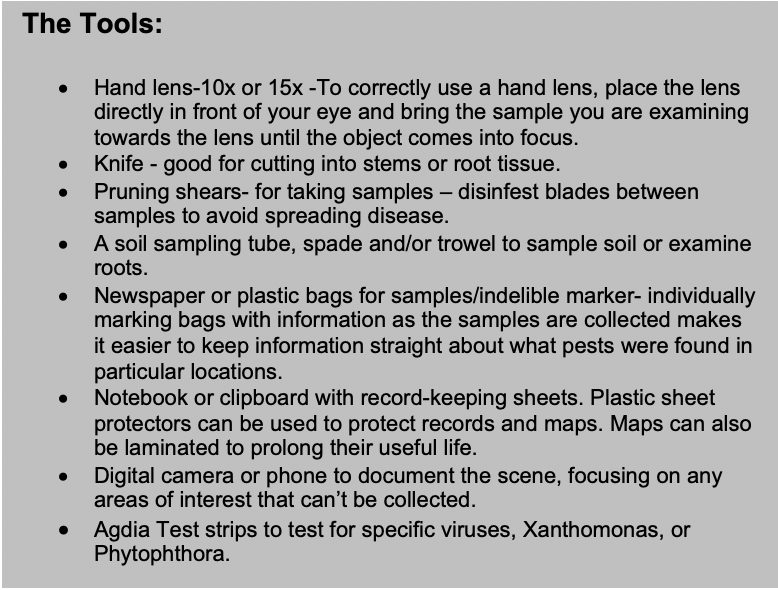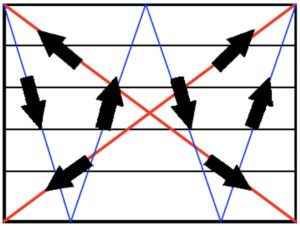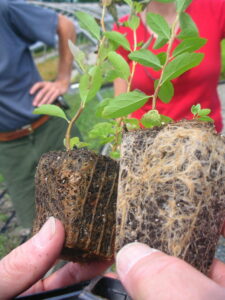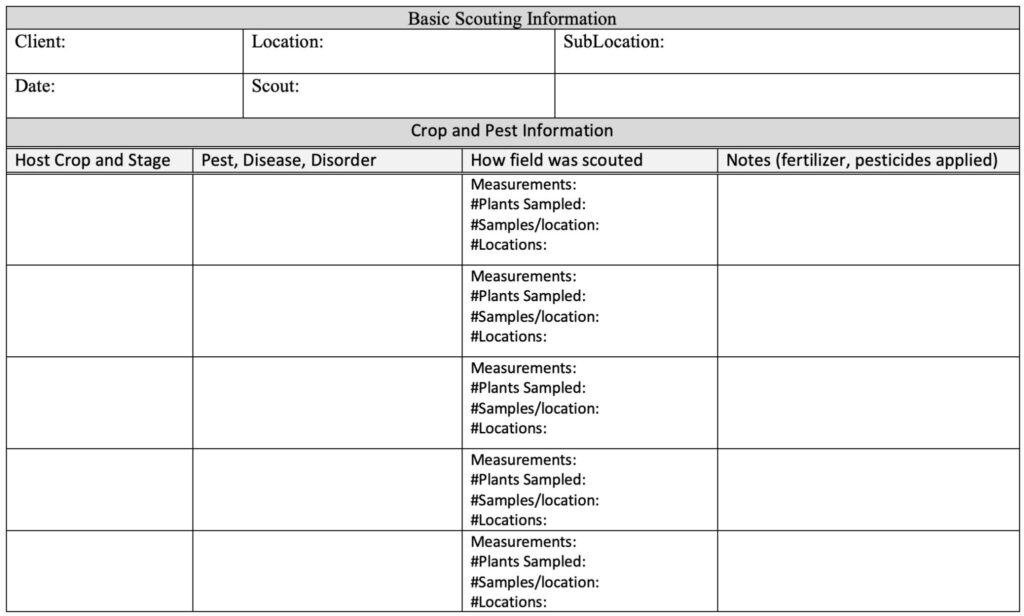Why Scout?
Pathogens, insects, weeds and other pests negatively impact ornamental plant production (greenhouse, nursery, landscape). Integrated pest management (IPM) strategies are used to prevent (ideally) or mitigate damage to ornamental crops. IPM strategies of ornamentals include practices such as proper plant choice for the site, incorporation of resistant varieties when available, the use of pesticides to manage problems, and an acceptance that certain levels of damage may be necessary. Unlike insect or weed pests, integrated disease management (IDM) has a very low economic threshold—a single lesion may contain thousands to millions of spores or bacteria. Under conducive environmental conditions, the inoculum in a single lesion can spread and initiate thousands of new infections. The goal of IDM is to prevent those lesions from forming in the first place. Early detection, sanitation and eradication improve overall disease management and are a foundation for good plant health management.
Scouting is the foundation of any IDM program. Scouting consists of systematically moving through the nursery, greenhouse or landscape looking for pathogens and pests, quantifying damage and evaluating thresholds. Scouting allows for the early identification of potential problems, providing more management options that can be implemented prior to a critical threshold, thereby reducing the control costs and crop losses. Since pest and pathogen populations vary, spraying without scouting (or spraying and praying) first may result in unnecessary or insufficient pesticide applications. A grower can use pesticides more effectively by knowing what pathogens are in a nursery , greenhouse or landscape, anticipating problems, and treating them before significant losses result.

How to scout

Figure 1. Scouting patterns. Remember: The goal is to quickly identify problems! Image source unknown.
There are innumerable pests (insects, diseases, and weeds) common to the greenhouse, nursery and landscape; All of these can be monitored by field scouting.
When scouting for pathogens or pests, it is important to get a random sample. However, the scout also needs to observe and note any high population areas (foci) in the field. Scouts should walk through the field in a “V,” “X,” or “W” pattern to get a random sample of pest populations within the field (Fig. 1). Anywhere from 25-100 plants should be randomly selected for examination, depending on the size of the greenhouse/nursery/landscape.
Random selection of plants is the key to an accurate indication of a pest or pathogen population. This doesn’t mean ignoring problems that you might see while scouting that don’t conform to your pattern! Remember the goal is to identify any problems early, not walk in a pattern.
Stick to scouting patterns while noting any areas of unusual plants or problems [e.g., areas of high pathogen or pest population, called focus areas or foci (plural)]. Take care to prevent insect or pathogen foci from skewing the results—these areas may warrant separate treatment plans, eradication, or additional applications of pesticide.
Where to scout:

Figure 2. Comparing healthy (right) to stunted plant (left). Unpotting the plant revealed root rot. Photo by Janna Beckerman.
Scouting is different depending upon how plants are propagated. In the greenhouse, cuttings should be examined prior to being stuck, with any spotted, distorted or discolored cuttings discarded. For seed-propagated plants, begin scouting for all pests (insects and diseases) at germination. This is especially important if there is a history of problems with damping-off, cutting rots, botrytis, downy mildew, and root rots, particularly Phytophthora and Pythium. When examining individual plants, observe the top, middle, and bottom canopy, as well as the main stem and roots, if present. Pots should be tipped sideways for inspection of the underside of the leaves where downy mildew is often first visible (and insects often hide). Remove plants from pots for root examinations on crops that are highly susceptible root rot (e.g., lavender, hellebore, mum) by inverting and removing the pot (Fig. 2).
In the nursery, scouting begins when whips or liners are potted (or up-potted) and again at budbreak. When examining individual plants, observe the top, middle, and bottom of the main stem along with any roots or root ball. Plants should be assessed for any external signs of botrytis, powdery mildew, cankers or root rot, and discard any obviously infected plants. These plants are more likely to serve as the start of an epidemic rather than a saleable plant. Continue scouting paying extra attention at bud break, not after the problem is identified. When examining individual plants, observe the top, middle, and bottom canopy, as well as the main stem and crown (root ball).
When scouting the wider nursery, consider the geography, including prevailing winds and rains, and field orientation (e.g., buildings or large trees that serve as windbreaks that increase humidity; farmer’s fields that may drift herbicide or serve as sources of white mold (Sclerotinia sclerotiorum); alternate hosts for rust diseases, etc. Note any low spots that tend to accumulate water (depressions in fields or nurseries; areas adjacent to evaporative cooling pads in greenhouses; leaks) taking care to look for botrytis, or water molds (downy mildews, Phytophthora, Pythium) that can debilitate plants.
When to Scout:
Disease scouting should begin as soon as planting or budbreak and continue throughout the entire growing season.
Draw a nursery/greenhouse map to identify blocks and problems areas from year to year. This is particularly important as many diseases are best controlled early in the season before symptoms are visible (e.g., powdery mildew, botrytis, apple scab). Waiting for symptoms to appear to begin fungicide applications can result in severe damage to some ornamental crops (i.e., Phytophthora or downy mildews on perennials; fire blight on crabapples, hawthorns, etc.). By incorporating scouting, and using survey information to plan treatments, disease problems can be managed proactively and efficiently.
Should an unknown problem be found, samples can be sent to the Purdue Plant and Pest Diagnostic office (www.purdue.edu/PPDL) for identification and management suggestions.
Record Keeping
As an IDM tool, scouting is only one the first part of IDM. Without proper records, scouting will be ineffective. An example scouting template example can be seen on the last page (Fig. 3). The greatest value derived from scouting is the record of what plants have problems and when they occur so you can be proactive in future years and prevent these problems from happening. The best way to do this is to keep and regularly review detailed records. Records and maps (greenhouse, nursery, blocks, landscape) provide a history of past problems and provide a leg-up on future diagnoses, showing where, when and what crops have had problems. Information should be compiled weekly and then examined at the end of the season to prepare for next year’s scouting and disease management. All of this is more easily said than done, but commitment to the process will provide dividends later, with improved yield, quality and plant health leading to happier clients in all of our industries.
When performed proactively, IPM saves growers money on chemical costs and reduces losses. It is the difference between planning and being proactive versus responding reactively to big losses. Developing a new IPM routine is hard and requires effort and intention. Begin by blocking a regular time to scout every week and allow time to record your efforts. Recognize that other demands in the greenhouse and/or nursery will compete with this time, so prioritize it by setting an alarm in your phone or setting up a team approach so it isn’t the responsibility of just one person. Keep in mind that this is process that will require repeated practice, but it is one that will pay dividends in better plant health and a better bottom line.

Figure 3. Example scouting template. Start getting into the scouting habit by keeping it simple. As scouting becomes a habit, expand what you scout and when you scout it, improving your process as you gain experience.